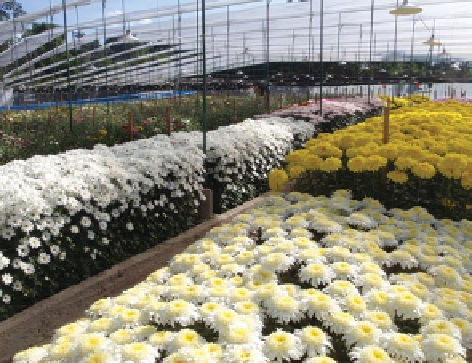Agriculture Reference
In-Depth Information
Fig. 11.16
Genetic varia-
tion in a Chrysanthemum
breeding programme. (Photo
credit: Jaap van Tuyl)
Genetic Variation
The variation of ornamentals across the world is enormous. Thousands of species
are used as ornamentation, as they occur in nature and as complex hybrid where
the variation is enlarged by application of breeding techniques. In the case of some
ornamental species like rose, chrysanthemum, tulip, lily, narcissus, tens of thou-
sands of cultivars have been bred. The history of breeding of ornamental plants goes
back many centuries, but only a few crops have been well documented (Kingsbury
2009
). For tulip, hyacinth and narcissus it has been described for 300-400 years
(Doorenbos
1954
). For rose and chrysanthemum (Fig.
11.16
) it can be traced back
to around 200 years (Zlesak
2006
; Anderson
2006a
,
b
). This is in contrast to the lily
with a relative short breeding history of less than 100 years (Van Tuyl and Arens
2011
). During domestication of the cultivated ornamental plant both inter-specific
hybridization and polyploidization played an important role. All available genetic
variation was used and through recombination, mutation and selection the variation
pool has been enlarged continuously. More recently modern breeding techniques
and tools like induced mutation induction, embryo rescue, artificial chromosome
doubling, haploidization, genetic modification, molecular assisted breeding and ge-
netic mapping are applied in ornamental breeding as well. Nowadays The Nether-
lands is leading in professional ornamental breeding (Van Tuyl
2012
).
Conclusions
Flowers form an integral part of human life. Flowers are beautiful, have important
symbolic significance, therapeutic and emotional value. Historically flowers are
used globally in traditions and celebrations in human life.

